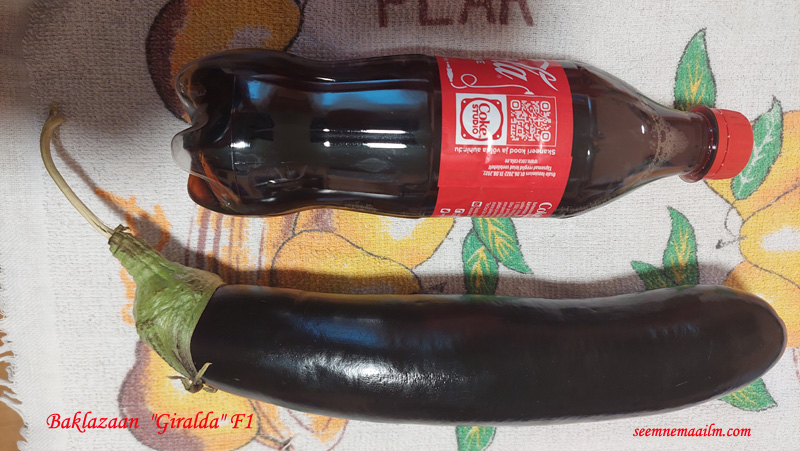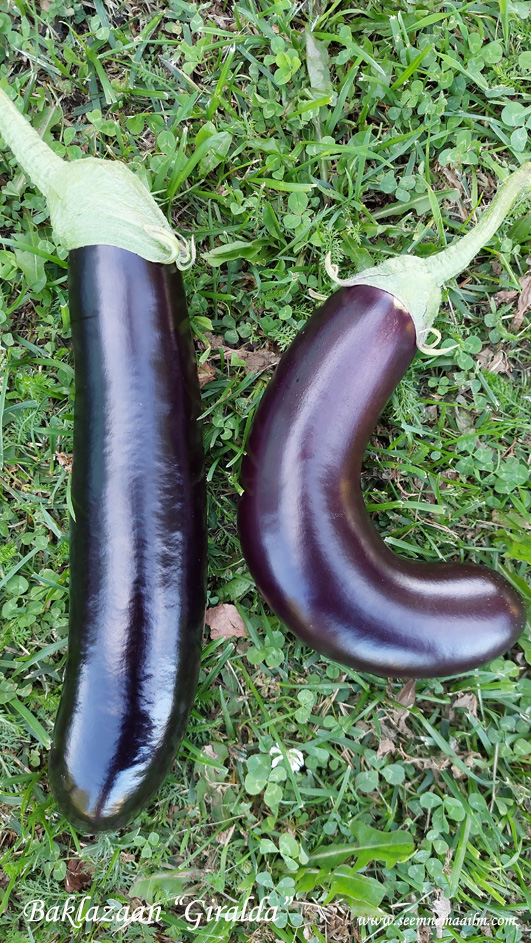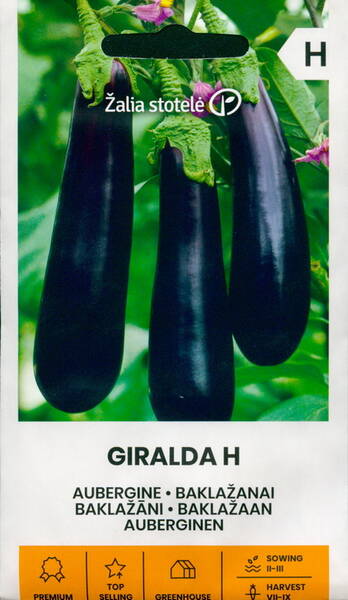Early hybrid variety. Fruits are large, 23 cm long, black, shiny, weighing up W 210 grams. Pulp is firm, white. Cultivated in glasshouses. Like humidity, watered with warm water in the first half of the day. Eggplants are low in calories. They contain 93.2 % of water, 3 % of sugar, up to 1.2 % of fiber, potassium and other salts. Also, a small amount of В group vitamins, vitamin С and carotene. Used fresh, fried, steamed, can be preserved.
1,0 g = 260 seeds.

Did you know that... if you get a cut while working in the garden, eggplant juice can serve as a substitute for antiseptic solutions like brilliant green.
Traditional healers have observed that a decoction made from eggplant calyxes (the green caps) acts as an effective antidote. It reduces blood alcohol levels in cases of alcohol poisoning, neutralizes the side effects of toxic berries and mushrooms, and even alleviates morning cough in smokers.
Therefore, we recommend not discarding the green calyxes of eggplants. Dry and preserve them. To prepare a healing decoction, simply steep 5 tablespoons of crushed dried calyxes in 1 liter of water and simmer over low heat for 20 minutes. The decoction should be consumed warm, in small portions.
Note: while traditional remedies can be supportive, serious medical conditions require professional healthcare consultation.

Eggplant. Bot.: Solanum melongena L.
How to Grow Eggplant in a Greenhouse?
In terms of biological characteristics and cultivation techniques, eggplant shares many similarities with pepper when grown in an unheated greenhouse...
The main difference is that eggplant is more demanding of heat. Therefore, before transplanting seedlings into the greenhouse, it is essential to ensure that temperatures will not drop below +15°C in case of cold weather.
Standard seedlings suitable for transplanting should be 10–12 cm tall with 5–7 true leaves, a well-developed root system that densely surrounds the soil ball, and a thick stem. Such seedlings can be easily removed from their containers without damaging the roots—this is crucial, as root damage is more dangerous for young plants than leaf loss or even partial stem damage.
For this reason, seedlings should be watered abundantly one day before transplanting to their permanent location, and weak or diseased plants should be discarded.
An important factor for eggplants is not only well-warmed air in the greenhouse but also soil warmed to a depth of about 20 cm (the temperature at this depth should not be below +15°C).
Heavy clayey, nutrient-poor soils remain cold for longer periods. Therefore, greenhouse soil should be loose, sandy-loamy, or light clayey in mechanical composition and rich in organic matter. If the greenhouse soil does not meet these criteria, apply large doses of high-quality compost or well-rotted manure (up to 10 kg per 1 m²), sand, and lime. Alternatively, mix sod soil and humus in a 3:1 ratio and spread this mixture over the soil surface in a layer 18–20 cm thick.
Before planting, apply mineral fertilizers: 10–20 g of ammonium nitrate, 30–40 g of superphosphate, and 15–20 g of potassium chloride.
Eggplants should be planted vertically in their permanent location without burying the root collar—the cotyledon leaves should remain above the soil surface.
Seedlings are planted in pre-prepared holes, first watered with warm water. After planting, gently but firmly press the soil around the seedlings, water them (about 2 liters per plant), and cover with loose soil to prevent crust formation.
Eggplant seedlings often have a well-developed leaf apparatus but an underdeveloped root system. If the weather is hot and dry the day after planting, and the roots were damaged during transplanting, the plants may lose more moisture than they absorb. This causes wilting and delays establishment. To improve survival rates, shade the newly planted seedlings.
Eggplant bushes can have a spreading form (height half the diameter), semi-spreading (height 1.5 times less than the diameter), or compact (height exceeds diameter). This characteristic largely determines planting density—spreading varieties are planted slightly less densely than compact ones. Plants are spaced 60x60 cm or 40x35 cm, depending on the bush form.
Eggplants are demanding of soil moisture. If moisture levels fall below 70–80% of field capacity, plants stunt growth, drop buds and fruits, and produce lower-quality harvests. However, eggplants also cannot tolerate waterlogged soil...
Watering is particularly important: eggplants should be watered frequently and only with warm water (not below +20°C), without interruptions, as periodic or even short-term drying significantly reduces yields.
During early growth, water once a week, ensuring the soil is moistened to a depth of about 20 cm. During fruiting, when plants may drop flowers and even fruits due to lack of moisture, water twice a week. The watering rate can be increased to 30 liters per 1 m². To reduce soil moisture evaporation, loosen the top layer to a depth of 3–5 cm (12–16 hours after each watering). However, note that eggplants have a robust root system mostly located in the topsoil, so loosen carefully near plants. Alternatively, mulch the soil with peat, cut grass, or straw.
When caring for eggplants in protected ground, combine high soil moisture with low air humidity—eggplants grow best at air humidity not exceeding 70% (water plants only in the morning, mulch the soil, and ensure regular ventilation).
Eggplants respond well to phosphorus fertilizers. They have high requirements for available potassium in the soil—a deficiency of this element causes leaf spot and fruit rot even in dry weather.
During the growing season, eggplants should be fertilized 6–8 times. Before fruiting, use complete mineral fertilizer (1.5 tablespoons of nitroammophoska per bucket of water). During fruiting, apply nitrogen-phosphorus fertilizers (20 g of ammonium nitrate and 30–40 g of superphosphate per bucket of water).
The round and pubescent stem of the eggplant is so sturdy that it remains upright until the end of the growing season and does not require staking. Its height depends on the variety and can range from 25 cm to 1.5 m.
During initial bush formation, identify and tie 2–3 of the strongest shoots to a trellis—each separately. All new shoots are removed once they reach 5–8 cm in length. After 8–9 true leaves have formed, shape the lateral shoots and large buds.
In addition to single large flowers, eggplants can produce inflorescences of 2–3 flowers. These should not be removed, as they can develop into standard fruits. Periodically remove diseased, damaged, and yellowed leaves and shoots.
In eggplants, the proportion of leaves and stems significantly exceeds that of flowers and fruits. The flowers, up to 5 cm in diameter, are arranged in the leaf axils in semi-umbels of 2–3 or singly. The calyx may sometimes develop subtle but sharp spines. This is a varietal trait, so fruits from such plants should be harvested carefully.
Since eggplants are self-pollinating, in greenhouse conditions, gently shake flowering plants to transfer pollen from anthers to the stigma. Shake in the morning hours for better fertilization. Eggplants set fruit only when direct sunlight reaches the flowers. Therefore, remove leaves that shade the flowers.
After the first or first two flowers bloom, subsequent flowers may appear only after 10–20 days, which is normal.
On average, 3–7 fruits form per plant, but if a variety can produce 8–15 fruits, this is considered a high yield.
When growing eggplants, fruit thinning should be done: leave no more than 5–6 fruits per plant. Leaving more will result in smaller fruits.
To achieve a good harvest, eggplants require ample light. Two important factors must be considered:
First, light intensity: eggplants should not be shaded during daylight hours. Even slight shading from neighboring plants, shrubs, trees, etc., reduces yields. Prolonged shading may result in no fruit production.
Second, day length: eggplants are short-day plants (no more than 14 hours). Reducing day length to 10–12 hours (with high light intensity) can accelerate fruiting and slightly increase yields. To shorten the day, construct a frame covered with light-proof material over the plants. Remove this material daily for 10–12 hours (e.g., from 8 AM to 7 PM). This must be done regularly, as irregular shading is harmful.












